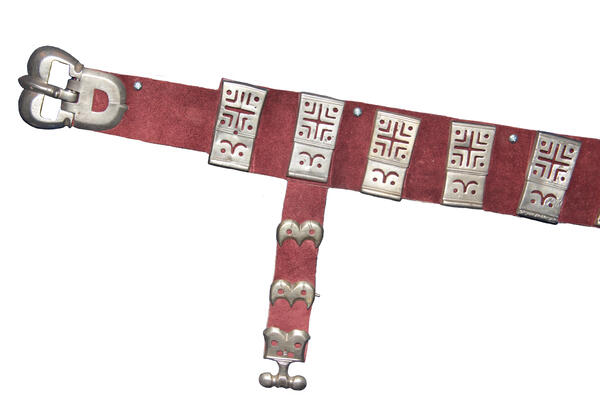The Kursk Regional Museum of Archaeology houses some items from the Gaponovo hoard, which was discovered near the northeastern outskirts of the village of Gaponovo (Krasnooktyabrskoye) in the Korenevsky district of the Kursk region. It contains a particular group of metal items — a set of men’s belt fittings.
Like most of the finds of ancient artifact hoards, this one was found by chance. There was a pioneer camp belonging to the low-voltage equipment factory “Rubilnik” on this territory. The hoard was discovered by local workers while laying a pipeline to the pioneer camp’s bathhouse. Elena Yurievna Arkhipova, the head of the chamber laboratory of the Left Bank Early Slavic Expedition of the Institute of Archaeology of the Russian Academy of Sciences, was on the site at the time. She documented the find and collected most of the items.
Later, the director of the plant, S.L. Rokhlin, and the archaeologists from Kursk Vladimir Vasilievich Enukov and Alexander Nikolayevich Apalkov helped to retrieve the missing things from the workers of the plant.
An archaeological trench was dug at the site of the find and the examination began. The hoard was in the archaeological deposit and, according to the finders, it was a dense spindle-shaped cluster of items. A total of 488 items were found. The belt set consisted of a buckle with a plate, belt tips, plaques, as well as a series of false buckles (belt plaques imitating buckles, but with a frame that did not let the belt slide through the hole). According to certain experts, the Gaponovo hoard consisted of at least two warrior’s belts. One of them was possibly a “ceremonial” belt and indicated the owner’s status; the other was a harness belt, where small buckles and tips could be used for suspending equipment.
This belt set is not unique: it is already the seventeenth site which contains items from both female and male sets of accessories. Such hoards are found in the territory that covers the forest-steppe and part of the forest zone of the Dnieper region, and were first discovered at the end of the 19th century. Since the excavations at the site of the hoard were carried out on a fairly limited area, it is difficult to date the items precisely. Archaeologists date the ornaments of the Gaponovo hoard to the middle of the 7th century. This is based on the material analogues, which have the above-mentioned dating in the numismatic material.
Like most of the finds of ancient artifact hoards, this one was found by chance. There was a pioneer camp belonging to the low-voltage equipment factory “Rubilnik” on this territory. The hoard was discovered by local workers while laying a pipeline to the pioneer camp’s bathhouse. Elena Yurievna Arkhipova, the head of the chamber laboratory of the Left Bank Early Slavic Expedition of the Institute of Archaeology of the Russian Academy of Sciences, was on the site at the time. She documented the find and collected most of the items.
Later, the director of the plant, S.L. Rokhlin, and the archaeologists from Kursk Vladimir Vasilievich Enukov and Alexander Nikolayevich Apalkov helped to retrieve the missing things from the workers of the plant.
An archaeological trench was dug at the site of the find and the examination began. The hoard was in the archaeological deposit and, according to the finders, it was a dense spindle-shaped cluster of items. A total of 488 items were found. The belt set consisted of a buckle with a plate, belt tips, plaques, as well as a series of false buckles (belt plaques imitating buckles, but with a frame that did not let the belt slide through the hole). According to certain experts, the Gaponovo hoard consisted of at least two warrior’s belts. One of them was possibly a “ceremonial” belt and indicated the owner’s status; the other was a harness belt, where small buckles and tips could be used for suspending equipment.
This belt set is not unique: it is already the seventeenth site which contains items from both female and male sets of accessories. Such hoards are found in the territory that covers the forest-steppe and part of the forest zone of the Dnieper region, and were first discovered at the end of the 19th century. Since the excavations at the site of the hoard were carried out on a fairly limited area, it is difficult to date the items precisely. Archaeologists date the ornaments of the Gaponovo hoard to the middle of the 7th century. This is based on the material analogues, which have the above-mentioned dating in the numismatic material.




